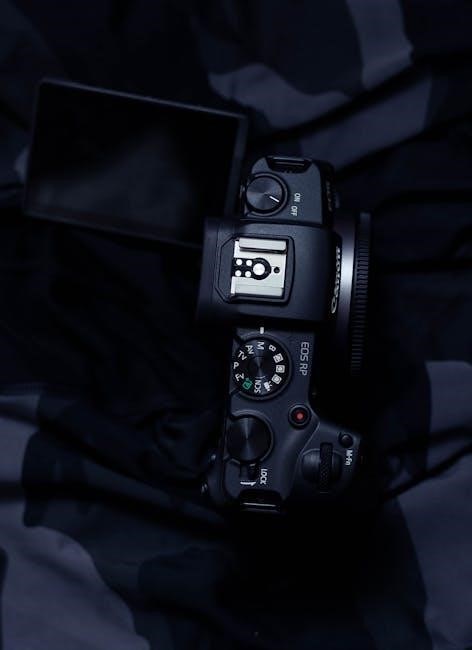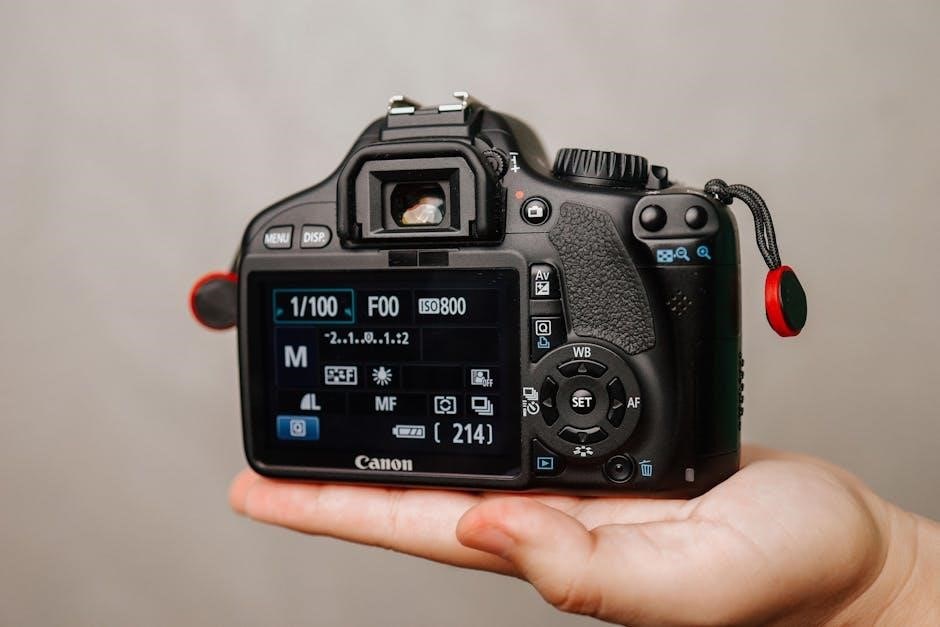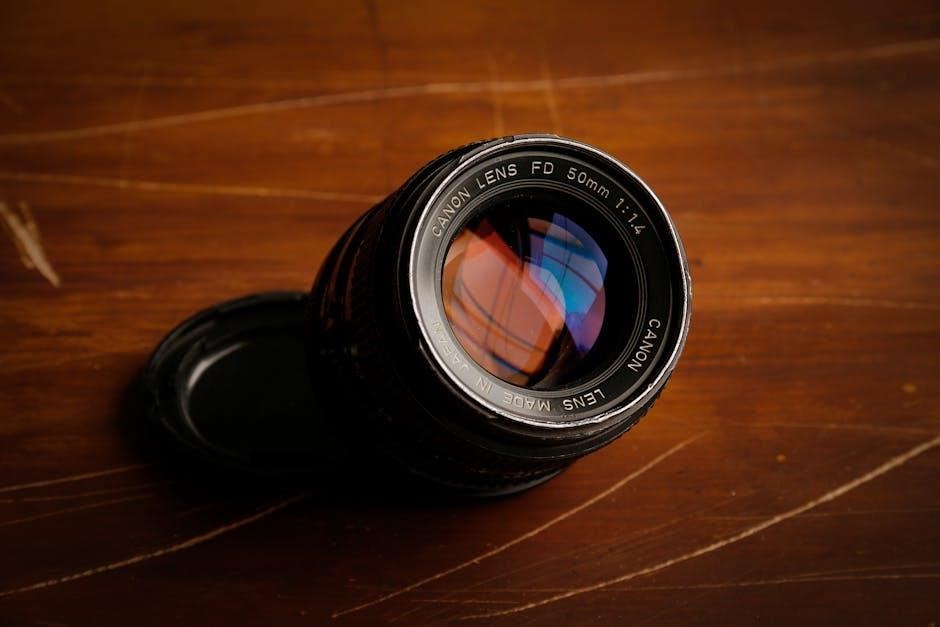
canon 350d manual
The Canon EOS 350D is a high-performance, 8-megapixel DSLR camera designed for versatile and speedy shooting. It features a CMOS sensor, EF lens compatibility, and user-friendly controls, making it ideal for both beginners and photography enthusiasts.
1.1 Overview of the Canon EOS 350D
The Canon EOS 350D is an 8-megapixel DSLR camera featuring a high-resolution CMOS sensor and compatibility with Canon EF lenses, including EF-S lenses. Designed for portability and ease of use, it offers versatile shooting modes, from automatic to manual, catering to both beginners and experienced photographers. The camera also includes a built-in flash and supports various accessories, making it a reliable choice for capturing high-quality images with precision and creativity.

1.2 Importance of the Manual for Optimal Use
The manual is essential for understanding the Canon EOS 350D’s features, ensuring proper usage, and avoiding errors. It provides detailed guidance on camera settings, shooting modes, and maintenance tips, helping users unlock the camera’s full potential. Reading the manual prevents mishandling, ensures safety, and aids in troubleshooting common issues, making it a vital resource for both beginners and experienced photographers to maximize their photography experience effectively.
Key Features and Specifications
The Canon EOS 350D is an 8-megapixel DSLR with a CMOS sensor, compatible with EF lenses, including EF-S. It features a 1.6x crop factor, various shooting modes, and a built-in flash, offering versatility for photographers of all levels.
2.1 Camera Specifications
The Canon EOS 350D features an 8-megapixel CMOS sensor with a 1.6x crop factor, ensuring high-resolution images. It includes a 2.0-inch LCD screen for preview and review. The camera is powered by the DIGIC II image processor, supporting various file formats like JPEG and RAW. With an ISO range of 100-1600, it offers flexibility in different lighting conditions. The EOS 350D also supports burst shooting up to 5 fps and uses SD/SDHC memory cards for storage. Its compact design and metal tripod mount enhance stability and durability.

2.2 Lens Compatibility
The Canon EOS 350D is compatible with all Canon EF lenses, including EF-S lenses, offering versatility for various photography needs. The camera features a 1.6x crop factor, which affects the effective focal length of lenses. While it doesn’t have built-in image stabilization, it supports lenses with IS technology. Popular kit lenses include the EF-S 18-55mm f/3.5-5.6, providing a practical starting point for photographers. This compatibility ensures a wide range of creative possibilities.
2.3 Sensor and Image Quality
The Canon EOS 350D features an 8-megapixel CMOS sensor, delivering high-resolution images with vibrant colors and good dynamic range. It supports various file formats, including JPEG and RAW, allowing flexibility in post-processing. The camera offers an ISO range of 100-1600, with noise reduction options for cleaner images in low-light conditions. The sensor’s performance ensures sharp details and accurate color reproduction, making it suitable for both casual and professional photography needs.

Setting Up the Camera
Unbox and charge the battery, then install a memory card. Familiarize yourself with the camera’s controls and settings to ensure optimal performance and personalized photography experience.
3.1 Unboxing and Initial Setup
Upon unboxing the Canon EOS 350D, you’ll find the camera body, battery, charger, and essential accessories. Before use, charge the battery fully and install a memory card. Familiarize yourself with the camera’s exterior, including the mode dial, buttons, and lens mount. Reading the manual is crucial to understand the camera’s features and settings, ensuring a smooth start to your photography journey.
3.2 Charging the Battery
To charge the Canon EOS 350D’s battery, use the provided charger. Insert the battery into the charger, ensuring it aligns correctly. Plug the charger into a power source and wait for the indicator to show charging progress. Allow the battery to charge fully before first use. Avoid overcharging, as it may reduce battery life. Always use Canon-approved chargers to ensure safety and optimal performance.
3.3 Memory Card Installation
Insert the memory card into the Canon EOS 350D by opening the card slot on the camera’s right side. Ensure the card is oriented correctly, with the label facing the camera. Gently push the card until it clicks into place. Use CF cards (Type I/II) for compatibility. After installation, format the card in the camera menu to ensure proper function. Avoid using multiple cards without formatting to prevent data issues.

Understanding the Camera Controls
The Canon EOS 350D features intuitive controls, including a mode dial, shutter button, and multi-controller. These components allow easy access to settings, ensuring efficient operation during photography sessions.

4.1 External Controls and Buttons
The Canon EOS 350D features a range of external controls designed for easy access to key functions. The mode dial allows quick selection of shooting modes, while the shutter button enables precise control over image capture. The multi-controller simplifies menu navigation and focus point selection. Additional buttons for ISO, white balance, and playback provide direct access to essential settings, streamlining the photography process for optimal results.
4.2 Mode Dial and Shooting Modes
The Canon EOS 350D features a convenient mode dial offering various shooting modes to suit different photography needs. Options include Full Auto for point-and-shoot simplicity, Program AE for automatic settings with user adjustments, and advanced modes like Av (Aperture Priority), Tv (Shutter Priority), and Manual for full creative control. Additional modes such as Portrait, Landscape, Close-up, Sports, and Night Portrait provide optimized settings for specific scenarios, catering to both beginners and experienced photographers.

Shooting Modes
The Canon EOS 350D offers a range of shooting modes, from automatic to manual, catering to both beginners and advanced photographers for enhanced creativity and control.
5.1 Automatic Modes
The Canon EOS 350D features automatic modes designed for ease of use, allowing beginners to capture stunning images without manual adjustments. These modes include Full Auto, Portrait, Landscape, Macro, Sports, and Night Scene, each optimizing settings for specific scenarios. The camera automatically adjusts aperture, shutter speed, and ISO, ensuring optimal results in various lighting conditions and subjects, making photography accessible and straightforward for new users.
5.2 Manual and Semi-Manual Modes
The Canon EOS 350D offers Manual (M), Aperture Priority (Av), and Shutter Priority (Tv) modes for advanced control. Manual mode allows full control over aperture, shutter speed, and ISO for precise adjustments. Aperture Priority enables manual aperture selection with automatic shutter speed adjustment, while Shutter Priority lets users set shutter speed manually with automatic aperture adjustment. These modes provide flexibility for creative photography, enabling users to achieve specific effects like background blur or motion freezing.
Menu System Navigation
The Canon EOS 350D menu system is intuitive, allowing easy access to settings via buttons and the multi-controller. Custom functions enable personalized camera configuration for enhanced shooting experiences.
6.1 Navigating the Main Menu
Access the main menu by pressing the MENU button. Use the multi-controller to navigate through options. Highlight desired settings with the SET button. Adjust values using the Quick Control Dial. Press MENU to exit. This system allows quick customization of camera functions, ensuring efficient operation during shooting sessions.
6.2 Custom Functions
Custom Functions allow personalized camera settings, enhancing shooting efficiency. Access via the main menu, these functions enable adjustments to autofocus, metering modes, and more. Use the multi-controller to select and the SET button to adjust. Custom Functions provide flexibility for tailored photography experiences, though changes should be made cautiously to avoid unintended camera behavior.
Image Quality Settings
The Canon EOS 350D offers customizable image quality settings, including JPEG and RAW file formats, compression levels, ISO sensitivity, noise reduction options, and white balance adjustments for optimal results.
7.1 File Formats and Compression
The Canon EOS 350D supports multiple file formats, including JPEG and RAW, allowing users to balance quality and storage needs. JPEG offers compressed files for everyday use, while RAW retains full image data for advanced editing. The camera also provides compression options, enabling users to adjust file size and quality based on their requirements. Understanding these settings ensures optimal image capture and storage efficiency for various photography scenarios.
7.2 ISO Settings and Noise Reduction
The Canon EOS 350D offers a range of ISO settings from 100 to 1600, with the option to extend to 3200 in 1-stop increments. This flexibility allows users to capture images in various lighting conditions. The camera also features noise reduction capabilities, minimizing grain in low-light shots. By adjusting ISO and enabling noise reduction, photographers can achieve cleaner, high-quality images even in challenging environments, ensuring optimal results for both casual and professional use.
7.3 White Balance and Color Space
The Canon EOS 350D offers multiple white balance settings, including Auto, Daylight, Shade, Tungsten, Fluorescent, and Custom, to ensure accurate color representation in various lighting conditions. The camera also supports sRGB and Adobe RGB color spaces, providing flexibility for different photographic needs. These features allow users to capture images with precise color accuracy, whether for professional editing or casual sharing, ensuring vibrant and true-to-life results in every shot.

Focusing and Metering
The Canon EOS 350D features a 7-point autofocus system for precise subject tracking and manual focus options for creative control. Metering modes include Evaluative, Center-Weighted, and Partial, ensuring accurate exposure in various lighting conditions.
8.1 Autofocus Modes
The Canon EOS 350D features a 7-point autofocus system, offering One-Shot AF for stationary subjects and AI Servo AF for tracking moving subjects. Manual Focus is also available for precise control. The camera automatically selects focus points or allows manual selection, ensuring flexibility in various shooting scenarios. This system enhances accuracy and speed, making it suitable for both still photography and dynamic action shots.
8.2 Manual Focus
The Canon EOS 350D allows for manual focus override, enabling precise control over focus settings. By switching the lens to MF mode and adjusting the focus ring, users can achieve sharp images in challenging situations. This feature is particularly useful for macro photography, portraits, or when autofocus struggles with low contrast scenes. Manual focus ensures creative control and accuracy in capturing desired results.
8.3 Metering Modes
The Canon EOS 350D offers three metering modes: Evaluative, Center-Weighted, and Spot Metering. Evaluative Metering analyzes the entire scene for balanced exposure. Center-Weighted prioritizes the central area, ideal for portraits. Spot Metering measures light from a specific spot, useful for high-contrast scenes. These modes can be selected via the camera’s menu or external controls, allowing photographers to adapt to various lighting conditions and achieve precise exposure control for their images.

Flash and Lighting
The Canon EOS 350D features a built-in pop-up flash and supports external flash units for enhanced lighting control. It utilizes E-TTL II technology for precise flash exposure.
9.1 Built-in Flash
The Canon EOS 350D features a built-in pop-up flash, activated via the camera’s controls. It uses E-TTL II technology for precise exposure control, automatically adjusting flash power based on scene conditions. The flash provides versatile lighting for various situations, from filling shadows in bright light to illuminating subjects in low-light environments. It is ideal for casual and amateur photography, offering a convenient lighting solution without the need for external units.
9.2 External Flash Units
The Canon EOS 350D supports external flash units, enhancing lighting control and creativity. Compatible with Canon’s E-TTL II system, these flashes ensure precise exposure. External units like the Speedlite series offer more power, flexibility, and advanced features. They can be mounted on the camera’s hot shoe or triggered wirelessly, providing versatile lighting solutions for professional and creative photography. This compatibility expands the camera’s capabilities beyond the built-in flash, offering superior results in challenging lighting conditions.
Accessories and Additional Equipment
The Canon EOS 350D supports a range of accessories, including lenses, tripods, and remote shutters, to enhance functionality and convenience for photographers of all levels.
10.1 Lenses and Lens Care
The Canon EOS 350D is compatible with all Canon EF lenses, including EF-S lenses, offering versatility for various photography needs. Proper lens care is essential for maintaining image quality. Use a soft, dry cloth to clean lenses, avoiding harsh chemicals. Regularly inspect for dust or smudges and store lenses in protective cases when not in use to prevent damage and ensure optimal performance.
10.2 Tripods and Remote Shutter Release
The Canon EOS 350D features a metal tripod socket, ensuring stability for long exposures or low-light photography. Using a tripod minimizes camera shake and blur, especially in challenging conditions. For added precision, a remote shutter release or the camera’s self-timer can be used to avoid physical contact with the camera during shooting. This setup is ideal for capturing sharp images in still-life, landscape, or astrophotography scenarios.

Troubleshooting Common Issues
Address error messages promptly and refer to the manual for solutions. Regular camera maintenance, such as cleaning the sensor and updating firmware, helps prevent common issues.
11.1 Error Messages and Solutions
Common error messages on the Canon EOS 350D include issues like “Memory card error” or “Lens not detected.” These often occur due to improper card formatting or lens misalignment. Refer to the manual for troubleshooting steps, such as reformatting the memory card or cleaning the lens contacts. For unresolved issues, contact Canon support or visit an authorized service center for professional assistance.
11.2 Camera Maintenance Tips
Regularly clean the camera sensor and lens with a soft, dry cloth to prevent dust buildup. Store the camera in a cool, dry place to avoid moisture damage. Use a UV filter to protect the lens from scratches. Avoid extreme temperatures and humidity. Clean the viewfinder and LCD screen gently with a microfiber cloth. For deep cleaning, consult the manual or contact a professional. Proper maintenance ensures optimal performance and longevity of your Canon EOS 350D.
Firmware and Software Updates
Regularly check for firmware updates on Canon’s official website to ensure optimal camera performance. Download and install the latest software to enhance functionality and fix issues.
12.1 Checking for Firmware Updates
To ensure your Canon EOS 350D operates at its best, regularly check for firmware updates on Canon’s official website. Visit the support section, select your camera model, and download the latest firmware if available. Updates often improve performance, add features, or fix issues. Always follow the provided instructions carefully to avoid errors during the update process.
12.2 Installing Firmware Updates
Installing firmware updates on your Canon EOS 350D is a straightforward process. Download the latest firmware from Canon’s official website and save it to your memory card. Insert the card into the camera, navigate to the firmware update option in the menu, and follow the on-screen instructions. Ensure the battery is fully charged and avoid interrupting the update process to prevent potential damage to the camera’s software.
Conclusion
The Canon EOS 350D is a versatile and powerful DSLR camera, offering excellent image quality and ease of use. This manual has guided you through its features, settings, and troubleshooting. Explore further to unlock its full potential and enhance your photography skills with confidence.
13.1 Summary of Key Points
The Canon EOS 350D is an 8-megapixel DSLR with a CMOS sensor, offering compatibility with EF lenses. It features various shooting modes, ISO settings, and white balance options for versatile photography. The camera supports firmware updates and includes a comprehensive manual for optimal use. Its compact design and user-friendly interface make it ideal for both beginners and enthusiasts, ensuring high-quality images and efficient operation.
13.2 Encouragement for Further Exploration
With the Canon EOS 350D, explore the world of photography by experimenting with its versatile features. Dive into manual modes, test ISO settings, and refine your skills with white balance adjustments. The camera’s compatibility with EF lenses opens up creative possibilities. Refer to the manual for guidance and online resources for tutorials. Keep practicing, and you’ll unlock the full potential of this reliable DSLR, capturing stunning images with ease and precision.